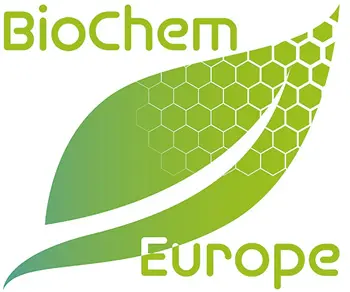What are biomass-derived chemicals?
What are biomass-derived chemicals?
Bio-based products are products wholly or partly derived from biomass. Biomass-derived chemicals are defined as chemical products that are wholly or partly derived from materials of biological origin (for example biomasses, feedstock, but also plants, algae, crops, trees, marine organisms and biological waste).
Definitions and standards
 Bio-based
Bio-based
derived from biomass. The methods to determine and communicate “bio-based” as a characteristic are detailed in specific standards of CEN/TC 411.
 Bio-based carbon/biogenic carbon
Bio-based carbon/biogenic carbon
carbon derived from biomass
 Bio-based carbon content
Bio-based carbon content
fraction of carbon derived from biomass in a product
 Bio-based content
Bio-based content
fraction of a product that is derived from biomass
 Bio-based product
Bio-based product
product wholly or partly derived from biomass
 Bio-based drop-in chemicals
Bio-based drop-in chemicals
bio-based versions of existing petrochemicals which have established markets. They are chemically identical to existing fossil-based chemicals.
 Smart drop-in bio-based chemicals
Smart drop-in bio-based chemicals
bio-based version of existing chemicals based on fossil hydrocarbons, but their bio-based pathways provide advantages compared to the conventional pathways. They are a special sub-group of drop-in chemicals.
 Dedicated bio-based chemicals
Dedicated bio-based chemicals
chemicals produced via a dedicated pathway that do not have an identical fossil-based counterpart
 Biodegradation
Biodegradation
degradation caused by biological activities, especially by enzymatic action, leading to a significant change in the chemical structure of a material
 Composting
Composting
natural biological decomposition of organic material in the presence of air to form a humus-like material.
 Biomass
Biomass
material of biological origin excluding material embedded in geological formations and/or fossilized
 Biorefinery
Biorefinery
facility that integrates biomass conversion processes and equipment to produce fuels, power and chemicals from biomass. The biorefinery concept is analogous to today’s petroleum refineries, which produce multiple fuels and products from petroleum. Industrial biorefineries have been identified as the most promising route to the creation of anew domestic bio-based industry.
Process
A journey into Industrial Biotechnologies applications
Industrial biotechnologies are a key enabler for the chemical sector as a whole, including biomass-derived chemistry.
Discover what it is and what it is used for …
Sustainability
Biomass-derived chemistry is instrumental to advancing the sustainability agenda. From the sourcing of feedstocks to the delivered products (building blocks, intermediates, platform chemicals, polymers, etc.), sustainability is at the core of biochemistry.
Biomass-derived chemistry has the potential to positively deliver on several of the United Nations Sustainable Development Goals (UN SDGs), such as:
No poverty
By valorizing biological feedstocks, notably from agriculture and forestry, the biomass-derived chemicals sectors contributes to maintaining rural livelihood, including in remote areas, and generating income for people and families whose living depends on land-use.
Good health and well being
Investments in biotechnology and biochemical research have led to significant breakthroughs that benefit health and well-being. It ranges from pharmaceutical and medical solutions to reduction of pollution, notably by substituting potential harmful chemicals and materials.
Clean water and sanitation
Biomass-derived chemicals’ relevance to water quality and cleanness is at least twofold: on the one hand, the switch to bio-based substances and materials can reduce the amount of pollutants in water, on the other biomass-derived chemicals can be extracted from waste water treatment sludges.
Affordable and clean energy
Biofuels, biogas and biokerosene are produced in chemical biorefineries and can either be used as fuels or as alternative to fossil fuels to produce intermediate chemicals. As such, they reduce the release of fossil carbon in the atmosphere.
Decent work and economic growth
By innovating and exploring solutions for a better life, the biomass-derived chemicals sector is likely to grow and contribute to the economy as well as to the creation of direct and indirect quality jobs. Over 10 years (2008-2017), its up to 10,000 new jobs that have been created.
Industry, innovation and infrastructure
The bioeconomy is an opportunity for large companies, but also SMEs and startups, to be competitive in Europe. As such it helps re-create an industrial base in Europe and, thanks to innovation, take the lead on global markets for novel drop-in and dedicated biomass-derived chemicals.
Responsible consumption and production
The combination of biomass feedstocks and circularity (re-use, re/up-cycling, biodegradability/compostability) makes biomass-derived chemicals among the role-models of sustainable production and consumption with a high potential for waste reduction, material recirculation and climate change mitigation.
Climate action
From the plant to the product, biomass-derived chemicals enable carbon dioxide absorption and storage as well as fossil emissions avoidance through substitution. Possibly combined with carbon capture and utilisation (CCU) in the future, biomass-derived chemistry might lead to “negative emissions”.
Life below water
The substitution of fossil materials with bio-based ones reduces the presence of long-to-degrade materials in marine environments (such as fossil-based plastics). At the same time, oceans and seas offer potential additional feedstocks for biomass-derived chemistry (e.g. algae).
Life on land
Provided biomass from agriculture and forestry is sourced responsibly, the bioeconomy and bio-based products can positively impact life on land, on the one hand by encouraging good management practices that reconcile the supply of raw materials with biodiversity and soil protection, on the other by delivering products that have limited to no negative impact during their use or end-of-life stages.
